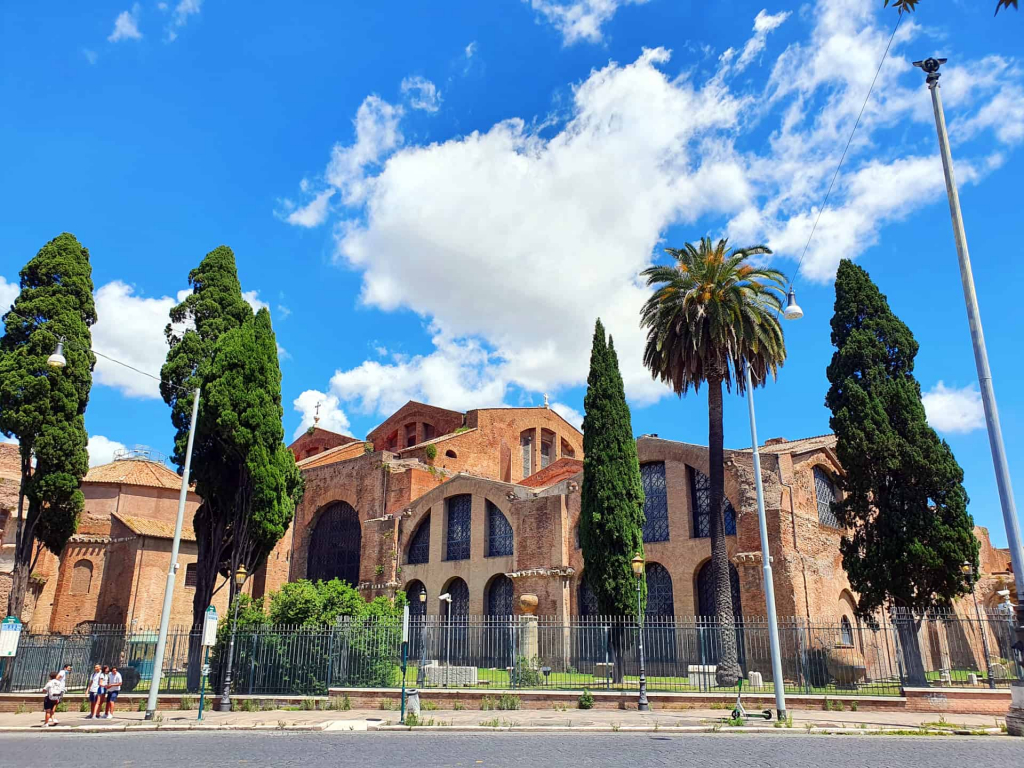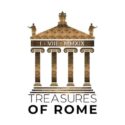
Castel Sant’Angelo
Castel Sant’Angelo (Castle of the Holy Angel / Mausoleum of Hadrian) is a historic landmark in Rome that has withstood the test of time. Originally built by Emperor Hadrian 135, as a final resting place, his mausoleum has served over time as part of the Aurelian Wall, a citadel, a prison, and a refuge for popes in times of emergency. Due to a long-standing illness, the emperor felt compelled to start the construction of his mausoleum in time. Previously, the mausoleum of Emperor Augustus had been sealed. The building was inaugurated in 139.
The structure had a circular shape with a large central cylinder and a square base. The exterior was covered with marble and decorated with statues and reliefs. Bull heads, garlands, gilded peacocks, a quadriga directed by the emperor and bronze equestrian statues completed the decoration.
The mausoleum was later used by other emperors and their families, including Marcus Aurelius. The last to be buried here was Caracalla in 217. Today, visitors can still see the original cylindrical structure, as well as the numerous additions and changes made over the centuries.
The foundation for its transformation into a castle was laid by Emperor Marcus Aurelius, who included the mausoleum in the fortification of the Aurelian Wall. It is considered the “most threatening and impregnable fortification” of the ancient world. Its proximity to the tomb of St. Peter ensured that Castel Sant’Angelo played a strategically central role for centuries.
In the 14th century, the papacy took over the building and transformed it into a fortress and residence for the pope. The transfer of Castel to the Holy See was one of the central conditions for the return of the popes from Avignon to Rome. The castle was connected to the Vatican by a secret passage known as the Passetto di Borgo, which allowed the Pope to escape in case of danger. This passage was built by Nicholas III.
The extension of the fortifications in the middle of the 15th century, made the Castel Sant’Angelo impregnable. It was never conquered by military means. In 1527 during the Sacco di Roma, Pope Clement VII took refuge in Castel Sant’Angelo and held out for 6 months.
The greatest restoration work took place in the first half of the 16th century under Pope Paul III. Particularly noteworthy are the “Sala Paolina” with its fresco cycles depicting Saint Paul, Alexander the Great and the Archangel Michael, and the Treasury. Most probably the ashes of Emperor Hadrian were kept there. Today there are the treasury chests of Pope Sixtus V who took care of the reorganization of the finances and solved the bandit problem.
Today, Hadrian’s Mausoleum is named after the Archangel Michael, who appeared over the castle in 590 and announced the end of the plague. The miracle occurred during a plague procession led by Pope Gregory the Great using the “Salus Populi Romani”. On the Pope’s orders, the mausoleum was renamed.
In 136 Hadrian had the “Pons Aelius”, today known as the Angel Bridge (Ponte Sant’angelo), built as an access to his final resting place. In ancient times it was considered the most beautiful bridge in the world. The 3 central arcades are still preserved in their original form. Today the entrance is guarded by the Apostle Princes Peter and Paul. 10 angels with Passion relics decorate the bridge. They were created by Bernini and his students, commissioned by Pope Clement IX.
Today, Castel Sant’Angelo is a popular museum that attracts visitors from all over the world. The museum showcases the castle’s rich history, with exhibits that include ancient artifacts, Renaissance-era paintings, and sculptures. Visitors can also explore the castle’s many rooms and corridors, including the papal apartments, the prison cells, and the castle’s famous spiral ramp. And of course, no visit to Castel Sant’Angelo is complete without a trip to the rooftop terrace, which offers breathtaking views of Rome and the surrounding countryside.

Castel Sant’Angelo (Rome)

Skip-the-Line tickets for the Castel Sant’Angelo in Rome
Opening hours:
Monday – Sunday: 09:00 – 19:30
Buy your tickets here and skip the line!
Everything You Need to Know About Buying Castel Sant’Angelo Tickets
Visiting Castel Sant’Angelo in Rome? Get up-to-date information and book your visit today with this essential guide to buying Castel Sant’Angelo tickets.
Is it free to enter Castel Sant’Angelo?
You can visit the gardens of the Castle free of charge. If you want to explore the museum you’ll have to buy a ticket. We recommend buying a ticket in advance to skip the lines because sometimes the lines can get quite long.
Is it worth going in Castel Sant’Angelo? What is special about Castel Sant’Angelo?
If our article has not yet convinced you of the significance of this sight here are a few reasons as a reminder:
Its historical significance having a rich history dating back to Roman times. The panoramic views of Rome from its rooftop terrace with breathtaking vistas of landmarks such as St. Peter’s Basilica, the Vatican City, and the Tiber River. Its architecture and art featuring a blend of Roman, medieval, and Renaissance styles.
How long does it take to walk through Castel Sant’Angelo?
On average, visitors typically spend about 1 to 2 hours exploring the castle thoroughly.


Treasures of Rome – Rome Guided Tours
Roberto Alois Lautenschlager Kung
[email protected]
Partita IVA: 17002181000
“ROMA AETERNA EST”
Rome is eternal – (Albius Tibullus)





